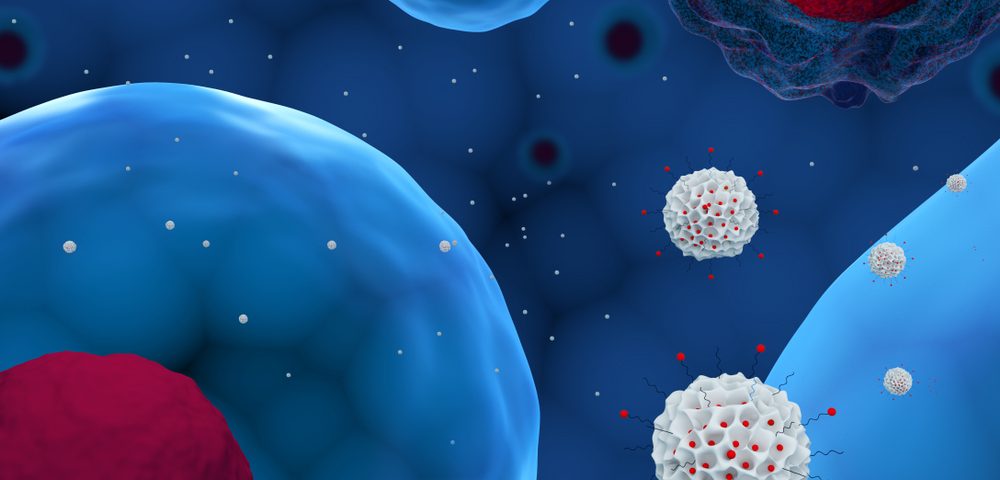A cell layer lining breast milk ducts called the myoepithelium plays an active and dynamic role in constraining cancer cells and preventing invasive breast cancer, a study shows.
The study, “Myoepithelial cells are a dynamic barrier to epithelial dissemination,” was published in the Journal of Cell Biology.
Most breast tumors are thought to develop from a group of cells called the luminal epithelial cells that line the inside of the breast milk ducts. Luminal epithelial cells are surrounded by another group of cells collectively called the myoepithelium.
The location of tumor cells relative to the myoepithelium dictates the aggressiveness of breast cancers.
When the cancer is restricted to the inside of the myoepithelium, it is called ductal carcinoma in situ (DCIS) and is less aggressive. When cancer cells escape across the myoepithelium and spread to the surrounding tissue, the cancer is more aggressive and called invasive ductal carcinoma (IDC).
In fact, the location of tumor cells in relation to the myoepithelium is still the most efficient way to distinguish DCIS from IDC, despite decades of analyzing mutation and gene expression profiles of these tumors.
As a result, all the data points to a critical role for the myoepithelium in maintaining tumor cells beneath the myoepithelial layer and implies that a breach in the integrity of myoepithelium is critical for development of IDC.
There are two schools of thought on how the myoepithelium works in blocking the escape of cancer cells. First, some researchers believe that the myoepithelium is like a wall in that once a gap is generated, the cancer cells can leave without any restriction. Secondly, some researchers believe the myoepithelium is dynamic in its response to and regulation of cancer cells.
“Understanding how cancer cells are contained could eventually help us develop ways to predict a person’s individualized risk of metastasis,” Andrew Ewald, PhD, a professor of cell biology at the Johns Hopkins University School of Medicine and member of the Johns Hopkins Sidney Kimmel Comprehensive Cancer Center, said in a press release.
To investigate this issue, the researchers developed a 3D culture that mimics normal mouse breast tissue to model the myoepithelial barrier function.
Studies have previously shown that a protein called Twist1 turns on genes that lead to the development of invasive cancer. So researchers manipulated luminal epithelial cells to produce Twist1 in order to visualize the escape of luminal epithelial cells through the myoepithelium.
Surprisingly, they saw that expression of Twist1 was rarely sufficient for escape through the myoepithelium. In fact, they discovered that the myoepithelial cells actually grabbed Twist1-positive (Twist1+) cells that tried to escape and pulled them backwards to constrain them within the breast duct lining.
“These findings establish the novel concept of the myoepithelium as a dynamic barrier to cell escape, rather than acting as a stone wall as it was speculated before,” said Katarina Sirka, a PhD student from the Ewald laboratory.
To validate their findings, researchers first depleted a protein called actin — which plays a major role in movement and contraction — from the myoepithelial cells. This led to a threefold increase in the number of Twist1+ cells that were able to escape through the myoepithelial layer.
Secondly, researchers reduced the proportion of myoepithelial cells to TWIST1+ cells, which led to an increase in the escape of TWIST1+ cells. Conversely, adding two myoepithelial cells for each invasive cell reduced the escape rate by fourfold.
“This is important to know because it suggests that both the physical completeness of the myoepithelium and the gene expression within the myoepithelial cells are important in predicting the behavior of human breast tumors. Anywhere this layer thins or buckles is an opportunity for cancer cells to escape,” said Eliah Shamir, MD, PhD, who is a surgical pathology fellow at the University of California, San Francisco.
“We demonstrated that the myoepithelium is a dynamic barrier to luminal epithelial dissemination and relies upon both contractility and adhesion for this function,” the investigators concluded in the study.

